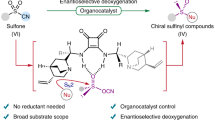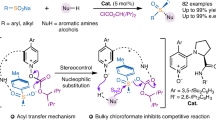Abstract
The stereocontrolled introduction of vicinal heteroatomic substituents into organic molecules is one of the most powerful ways of adding value and function. Although many methods exist for the introduction of oxygen- and nitrogen-containing substituents, the number of stereocontrolled methods for the introduction of sulfur-containing substituents pales by comparison. Previous reports from our laboratories have described sulfenofunctionalizations of alkenes that construct carbon–sulfur bonds vicinal to carbon–oxygen, carbon–nitrogen or carbon–carbon bonds with high levels of diastereospecificity and enantioselectivity. This process is enabled by the concept of Lewis-base activation of Lewis acids, which provides activation of Group 16 electrophiles. To provide a foundation for the expansion of substrate scope and improved selectivities, we have undertaken a comprehensive study of the catalytically active species. Insights gleaned from kinetic, crystallographic and computational methods have led to the introduction of a new family of sulfenylating agents that provide significantly enhanced selectivities.
This is a preview of subscription content, access via your institution
Access options
Subscribe to this journal
Receive 12 print issues and online access
$259.00 per year
only $21.58 per issue
Buy this article
- Purchase on Springer Link
- Instant access to full article PDF
Prices may be subject to local taxes which are calculated during checkout




Similar content being viewed by others
References
Metzner, P. & Thuillier, A. Sulfur Reagents in Organic Synthesis (Academic Press, 1994).
Page, P. (ed.) Organosulfur Chemistry: Synthetic Aspects (Academic Press, 1995).
Prinsep, M. R. Sulfur-containing natural products from marine invertebrates. Stud. Nat. Prod. Chem. 28, 617–751 (2003).
de la Mare, P. B. D. & Bolton, R. (eds) in Electrophilic Additions to Unsaturated Systems 2nd edn, Vol. 9, 198–246 (Elsevier, 1982).
Smit, W. A., Zefirov, N. S., Bodrikov, I. V. & Krimer, M. Z. Episulfonium ions: myth and reality. Acc. Chem. Res. 12, 282–288 (1979).
Rayner, C. M. in Organosulfur Chemistry: Synthetic Aspects (ed. Page, P.) Ch. 3 (Academic Press, 1995).
Archer, N. J., Rayner, C. M., Bell, D. & Miller, D. Synthetic routes to novel homochiral sulfenyl sulfonium salts and their use as potential enantioselective sulfenylating agents. Asymmetric synthesis via homochiral thiiranium ions. Synlett. 617–619 (1994).
Lucchini, V., Modena, G. & Pasquato, L. Enantiopure thiosulfonium salts in asymmetric synthesis. Face selectivity in electrophilic additions to unfunctionalised olefins. J. Chem. Soc. Chem. Commun. 1565–1566 (1994).
Marigo, M., Wabnitz, T. C., Fielenbach, D. G. & Jørgensen, K. A. Enantioselective organocatalyzed α-sulfenylation of aldehydes. Angew. Chem. Int. Ed. 44, 794–797 (2005).
Zhao, G.-L., Rios, R., Vesely, J., Eriksson, L. & Córdova, A. Organocatalytic enantioselective aminosulfenylation of α,β-unsaturated aldehydes. Angew. Chem. Int. Ed. 47, 8468–8472 (2008).
Sobhani, S., Fielenbach, D. G., Marigo, M., Wabnitz, T. C. & Jørgensen, K. A. Direct organocatalytic asymmetric α-sulfenylation of activated C–H bonds in lactones, lactams, and β-dicarbonyl compounds. Chem. Eur. J. 11, 5689–5694 (2005).
Han, Z. et al. Highly enantioselective organocatalytic sulfenylation of 3-aryloxindoles. Org. Lett. 14, 4670–4673 (2012).
Guan, H., Wang, H., Huang, D. & Shi, Y. Enantioselective oxysulfenalytion and oxyselenylation of olefins catalyzed by chiral Brønsted acids. Tetrahedron 68, 2728–2735 (2012).
Hamilton, G. L., Kanai, T. & Toste, F. D. Chiral anion-mediated asymmetric ring opening of meso-aziridinium and episulfonium ions. J. Am. Chem. Soc. 130, 14984–14986 (2008).
Lin, S. & Jacobsen E. N. Thiourea-catalysed ring opening of episulfonium ions with indole derivatives by means of stabilizing non-covalent interactions. Nature Chem. 4, 817–824 (2012).
Denmark, S. E. & Beutner G. L. Lewis base catalysis in organic synthesis. Angew. Chem. Int. Ed. 47, 1560–1638 (2008).
Denmark, S. E. & Collins, W. R. Lewis base activation of Lewis acids: development of a Lewis base catalyzed selenolactonization. Org. Lett. 9, 3801–3804 (2007).
Denmark, S. E., Kalyani, D. & Collins, W. R. Preparative and mechanistic studies toward the rational development of catalytic, enantioselective selenoetherification reactions. J. Am. Chem. Soc. 132, 15752–15765 (2010).
Denmark, S. E., Collins, W. R. & Cullen, M. D. Observation of direct sulfenium and selenenium group transfer from thiiranium and seleniranium ions to alkenes. J. Am. Chem. Soc. 131, 3490–3492 (2009).
Denmark, S. E. & Vogler, T. Synthesis and reactivity of enantiomerically enriched thiiranium ions. Chem. Eur. J. 15, 11737–11745 (2009).
Denmark, S. E., Kornfilt, D. J. P. & Vogler, T. Catalytic asymmetric thiofunctionalization of unactivated alkenes. J. Am. Chem. Soc. 133, 15308–15311 (2011).
Denmark, S. E. & Chi, H. M. Catalytic, enantioselective, intramolecular carbosulfenylation of olefins. Mechanistic aspects: a remarkable case of negative catalysis. J. Am. Chem. Soc. 136, 3655–3663 (2014).
Denmark, S. E. & Jaunet, A. Catalytic, enantioselective, intramolecular carbosulfenylation of olefins. J. Am. Chem. Soc. 135, 6419–6422 (2013).
Denmark, S. E. & Jaunet, A. Catalytic, enantioselective, intramolecular carbosulfenylation of olefins. Preparative and stereochemical aspects. J. Org. Chem. 79, 140–171 (2014).
Denmark, S. E. & Chi, H. M. J. Am. Chem. Soc. 136, 8915–8918 (2014).
Krossing, I. & Raabe, I. Noncoordinating anions—fact or fiction? A survey of likely candidates. Angew. Chem. Int. Ed. 43, 2066–2090 (2004).
Hartmann, F., Dahlems, T. & Mootz, D. Crystal structure of hexamethylphosphoric triamide (C2H3N)3PO. Z. Kristallogr. New Cryst. Struct. 213, 639–640 (1998).
Denmark, S. E. & Eklov, B. M. Neutral and cationic phosphoramide adducts of silicon tetrachloride: synthesis and characterization of their solution and solid-state structures. Chem. Eur. J. 14, 234–239 (2008).
Arduengo, A. J. & Burgess, E. M. Tricoordinate hypervalent sulfur-compounds. J. Am. Chem. Soc. 99, 2376–2378 (1977).
Kuhn, N., Bohnen, H., Fahl, J., Bläser, D. & Boese, R. Koordination oder Reduktion? Zur Reaktion von 1,3-Diisopropy1-4,5-dimethylimidazol-Zyliden mit Schwefelhalogeniden und Schwefeloxidhalogeniden. Chem. Ber. 129, 1579–1586 (1996).
Godfrey, S. M., Ollerenshaw R. T. A., Pritchard, R. G. & Richards, C. L. Structural isomerism in R3PSe(Ph)I compounds: the ionic structure of [(Me2N)3PSePh]I. J. Chem. Soc. Dalton Trans. 508–509 (2001).
Goldstein, E., Beno, B. & Houk, K. N. Density functional theory prediction of the relative energies and isotope effects for the concerted and stepwise mechanisms of the Diels–Alder reaction of butadiene and ethylene. J. Am. Chem. Soc. 118, 6036–6043 (1996).
Cantillo, D. & Kappe, C. O. A unified mechanistic view on the Morita–Baylis–Hillman reaction: computational and experimental investigations. J. Org. Chem. 75, 8615–8626 (2010).
Denmark, S. E. & Pham, S. M. Kinetic analysis of the divergence of reaction pathways in the chiral Lewis base promoted aldol addition of trichlorosilyl enolates: a rapid injection NMR study. Helv. Chim. Acta 83, 1846–1853 (2000).
Sølling, T. I. & Radom, L. A G2 study of SH+ exchange reactions involving lone-pair donors and unsaturated hydrocarbons. Chem. Eur. J. 7, 1516–1524 (2001).
Sølling, T. I., Wild, S. B. & Radom, L. Are pi-ligand exchange reactions of thiirenium and thiiranium ions feasible? An ab initio investigation. Chem. Eur. J. 5, 509–514 (1999).
Sølling, T. I., Wild, S. B. & Radom, L. Are the approach directions of σ and π nucleophiles to the sulfur atom of thiiranium and thiirenium ions different? Chem. Eur. J. 6, 590–591 (2000).
Modena, G., Pasquato, L. & Lucchini, V. Different approaching directions of σ and π nucleophiles to the sulfur atom of thiiranium and thiirenium ions. Chem. Eur. J. 6, 589–590 (2000).
Fachini, M., Lucchini, V., Modena, G. Pasi, M. & Pasquato, L. Nucleophilic reactions at the sulfur of thiiranium and thiirenium ions. New insight in the electrophilic additions to alkenes and alkynes. Evidence for an episulfurane intermediate. J. Am. Chem. Soc. 121, 3944–3950 (1999).
Bach, R. D., Andres, J. L., Owensby, A. L., Schlegel, H. B. & McDouall, J. J. W. Electronic structure and reactivity of dioxirane and carbonyl oxide. J. Am. Chem. Soc. 114, 7207–7217 (1992).
Houk, K. N., Liu, J., Demello, N. C. & Condroski, K. R. Transition states of epoxidations: diradical character, spiro geometries, transition state flexibility, and the origins of stereoselectivity J. Am. Chem. Soc. 119, 10147–10152 (1997).
Dmitrenko, O. & Bach, R. D. Reassessment of the level of theory required for the epoxidation of ethylene with dioxiranes. J. Phys. Chem. A 108, 6886–6892 (2004).
Becke, A. D. Density-functional thermochemistry. III. The role of exact exchange. J. Chem. Phys. 98, 5648–5652 (1993).
Lee, C., Yang, W. & Parr, R. G. Development of the Colle–Salvetti correlation-energy formula into a functional of the electron density. Phys. Rev. 37, 785–789 (1988).
Barone, V. & Cossi, M. Quantum calculation of molecular energies and energy gradients in solution by a conductor solvent model. J. Phys. Chem. A 102, 1995–2001 (1998).
Cossi, M., Rega, N., Scalmani, G. & Barone, V. Energies, structures, and electronic properties of molecules in solution with the C-PCM solvation model. J. Comput. Chem. 24, 669–681 (2003).
Ess, D. H. & Houk, K. N. Theory of 1,3-dipolar cycloadditions: distortion/interaction and frontier molecular orbital models. J. Am. Chem. Soc. 130, 10187–10198 (2008).
Glendening, E. D., Reed, A. E., Carpenter, J. E. & Weinhold, F. NBO Version 3.1 (Theoretical Chemistry Institute, University of Wisconsin, 2001).
Acknowledgements
The authors acknowledge financial support from the National Institutes of Health (GM R01-085235). E.H. thanks the Deutscher Akademischer Austauschdienst for a postdoctoral fellowship. D.J-P.K. thanks the University of Illinois for a Seemon H. Pines Graduate Fellowship in Synthetic Organic Chemistry. The authors thank L.M. Wolf (MPI-Mühlheim) for assistance with the computational analysis.
Author information
Authors and Affiliations
Contributions
E.H. planned and carried out the experimental work and obtained the X-ray structure of 5b. D.J-P.K. carried out the kinetic analysis and H.W. performed the transition state calculations. S.E.D. initiated and directed the project. E.H. wrote the manuscript with the assistance of the other authors.
Corresponding author
Ethics declarations
Competing interests
The authors declare no competing financial interests.
Supplementary information
Supplementary information
Supplementary information (PDF 4612 kb)
Supplementary information
Crystallographic data for compound (±)-5b (CIF 56 kb)
Supplementary information
Crystallographic data for compound S5 (CIF 36 kb)
Rights and permissions
About this article
Cite this article
Denmark, S., Hartmann, E., Kornfilt, D. et al. Mechanistic, crystallographic, and computational studies on the catalytic, enantioselective sulfenofunctionalization of alkenes. Nature Chem 6, 1056–1064 (2014). https://doi.org/10.1038/nchem.2109
Received:
Accepted:
Published:
Issue Date:
DOI: https://doi.org/10.1038/nchem.2109
This article is cited by
-
Mechanochemical synthesis of organoselenium compounds
Nature Communications (2024)
-
Selenide-catalyzed enantioselective synthesis of trifluoromethylthiolated tetrahydronaphthalenes by merging desymmetrization and trifluoromethylthiolation
Nature Communications (2018)
-
A bioinspired and biocompatible ortho-sulfiliminyl phenol synthesis
Nature Communications (2017)



